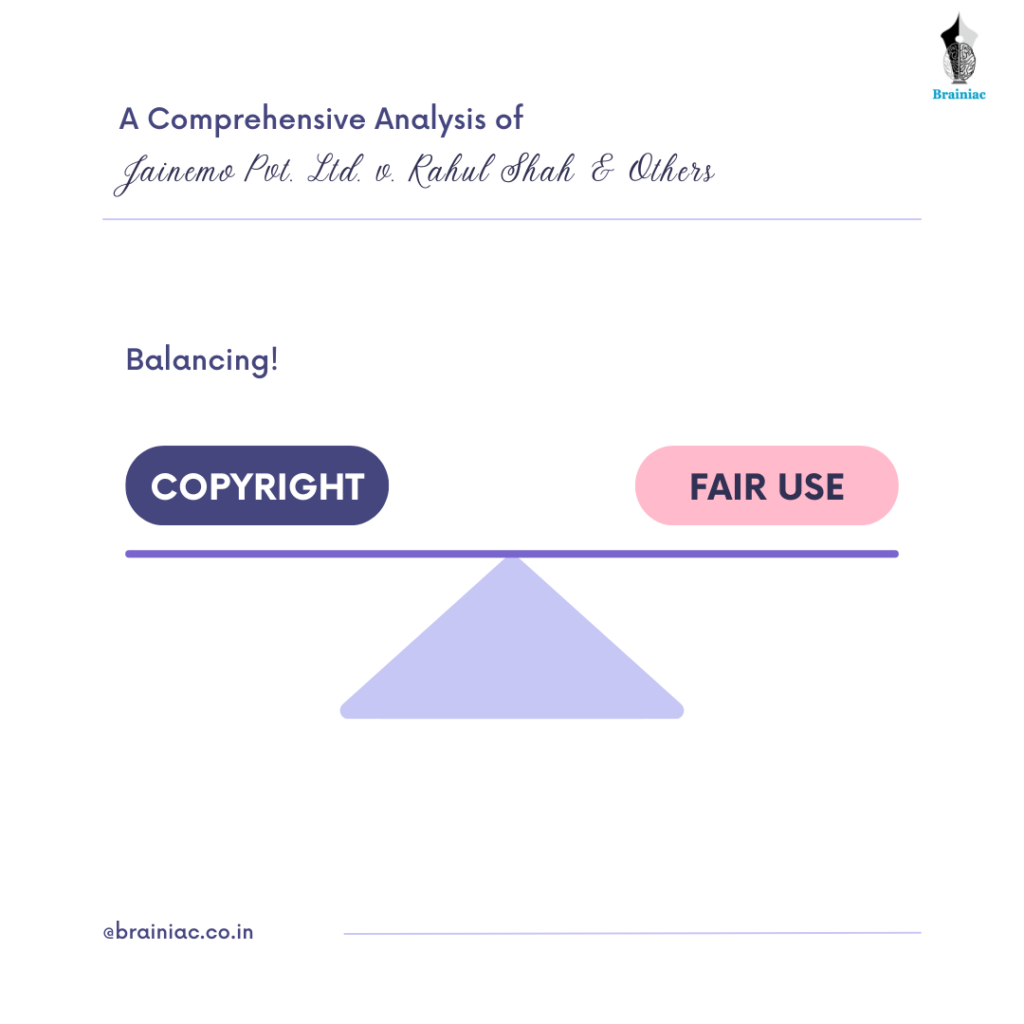Introduction
In today’s digital age, where the internet has transformed how we access and share information, the balance between protecting copyrights and the public’s right to knowledge is more important than ever. The recent judgment in the case of Jainemo Pvt. Ltd. v. Rahul Shah and others, issued by the Delhi High Court, reignites this ongoing discussion. It sheds light on the intersection of copyright law and the fair use doctrine as outlined in the Copyright Act of 1957. This article dives deep into the intricate legal issues brought up in the case, with a specific focus on the elusive “purpose test” within the fair use doctrine.
Analysis of the Case
The case Jainemo Pvt. Ltd. v. Rahul Shah and others allows us to dig deep into copyright law, especially concerning the fair use doctrine and the purpose test. The plaintiff in the present case, Jainemo Pvt. Ltd. is a company engaged in creating and disseminating educational courses through its website, apnacollege.in. These courses cover a range of topics, including coding, computer programming, website development, and more. Jainemo’s educational content is highly regarded and widely used, with students accessing these materials through their website.
The Defendants in this case were private individuals or entities who allegedly engaged in copyright infringement by sharing Jainemo’s copyrighted educational materials and videos on various digital platforms. These platforms included popular messaging apps like WhatsApp and Telegram, as well as video-sharing platforms like YouTube. Several important issues were discussed during the case, considering the purpose test:
Reproduction vs. Publication:
The Defendants were said to have shared the Plaintiff’s copyrighted “course material” and “videos” on digital platforms. The court found that the Defendants were making money from this by charging fees for access to the copyrighted material. Because of this commercial aspect, the court labelled their actions as “publication” instead of just “reproduction.” This made them ineligible for the fair use exception under Section 52(1)(i) of the Copyright Act.
Impact on the Market :
The court determined that the Defendants’ actions were harming the Plaintiff’s market. By offering lower prices and discouraging real customers, the Defendants were seen as working against the fair use principle. The purpose test demands that the use should be necessary for educational purposes and should not hurt the market.
Nature of the Infringement:
The court indirectly recognized that the Defendants’ actions didn’t fit the “educational exception.” Instead, they were seen as making money from unauthorized sharing of copyrighted material, which goes against fair use and the purpose test.
Decision of the Court
Justice Pratibha Singh, in her ruling, confirmed that Jainemo’s course materials are considered ‘literary works,’ and the accompanying videos meet the criteria for ‘cinematographic films,’ under section 13 and section 14 of the Copyright Act, 1957, which means they are protected by copyright. She acknowledged the potential financial harm Jainemo could suffer if the entities were not stopped from unlawfully sharing educational materials. As a result, she issued an order to prevent them from downloading, uploading, storing, sharing, or using any of the copyrighted materials. Furthermore, she called on Telegram, YouTube, and WhatsApp to take steps against these wrongdoers by blocking or suspending their channels.
The Purpose Test: An Insight
The fair use doctrine is a vital part of copyright law, allowing some uses of copyrighted material without needing permission or payment to the copyright owner. In the Copyright Act, 1957, Section 52(1)(i) lays out exceptions to copyright infringement. It’s crucial for educational purposes, like when teachers or students use copyrighted material in their teaching and learning.
On the other hand, the “purpose test” is the key idea that decides whether using copyrighted material is within the purview of fair use or not. It looks at whether using copyrighted material is necessary for a fair reason, especially in education. In simple terms, if you need to use copyrighted material to teach, learn, or achieve a specific educational goal, it’s considered fair and legal. But if you’re using it for commercial benefits or hurting the market for the original work, it might not pass the purpose test.
For example, if a teacher reproduces a portion of a copyrighted textbook for distribution to students in a classroom, the purpose test would consider whether this reproduction is vital for instructional purposes, thus making it a fair use. However, if the reproduction serves a different, non-educational purpose or harms the market for the original work, it may not meet the requirements of the purpose test.
Conclusion
In conclusion, the case is a fascinating example that highlights the complex issues of copyright infringement and fair use. It underscores the importance of finding the right balance between protecting copyrights and ensuring the public can access knowledge, especially when considering the “purpose test.” In today’s digital world, where technology keeps changing the rules of copyright and fair use, it’s crucial to have a smart approach to copyright law. This case is a valuable reference for legal experts, professionals, and policymakers in the field of intellectual property.



